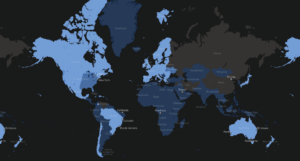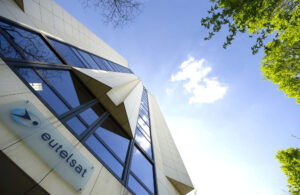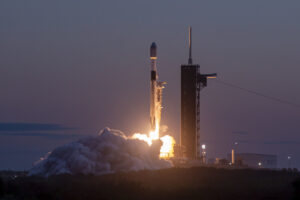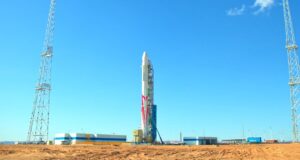U.S. space internet companies fear competitive threat from China
Wednesday, 14 December 2022 22:16
U.S. government should “enact policies and incentives to keep U.S. LEO broadband companies competitive internationally," says a new CSIS report.
The post U.S. space internet companies fear competitive threat from China appeared first on SpaceNews.
U.S. national security space strategy emphasizes resilient systems, responsible behavior
Wednesday, 14 December 2022 20:52
A recently completed U.S. space strategy stresses the need to deploy resilient constellations that can operate under attack, and supports norms for responsible behavior in space
The post U.S. national security space strategy emphasizes resilient systems, responsible behavior appeared first on SpaceNews.
Eutelsat ordered to stop broadcasting three Russian channels
Wednesday, 14 December 2022 20:33
France’s TV regulator ordered Paris-based satellite operator Eutelsat to stop broadcasting three Russian propaganda channels, reversing an earlier decision not to interfere.
The post Eutelsat ordered to stop broadcasting three Russian channels appeared first on SpaceNews.
Space launch supply chokepoint puts U.S. in vulnerable spot, expert warns
Wednesday, 14 December 2022 16:49
The U.S. government has to face the prospect of having to rely on a single launch provider
The post Space launch supply chokepoint puts U.S. in vulnerable spot, expert warns appeared first on SpaceNews.
Historic first launch of Chinese private methane-fueled rocket ends in failure
Wednesday, 14 December 2022 15:43
Chinese launch company Landspace suffered failure Wednesday in what was the world's first attempt to achieve orbit with a methane-fueled rocket.
Satellogic signs letter of intent with Mexico for dedicated EO program
Wednesday, 14 December 2022 10:11 Satellogic Inc. (NASDAQ: SATL), a leader in sub-meter resolution Earth Observation ("EO") data collection, has signed a letter of intent (the "LOI") with Agencia Espacial Mexicana ("AEM") to develop a fully-featured and operational Constellation-as-a-Service program to monitor approximately 2 million square kilometers of the nation.
The LOI provides a framework for the development of a Con
Satellogic Inc. (NASDAQ: SATL), a leader in sub-meter resolution Earth Observation ("EO") data collection, has signed a letter of intent (the "LOI") with Agencia Espacial Mexicana ("AEM") to develop a fully-featured and operational Constellation-as-a-Service program to monitor approximately 2 million square kilometers of the nation.
The LOI provides a framework for the development of a Con Keeping the peace as competition rises in space
Wednesday, 14 December 2022 10:11 With the rise of commercialized space flight and the threat of significant weaponization of space, it will take an international effort to develop and adopt agreed-upon regulations to maintain safety, according to speakers at a Duke Space Diplomacy Lab webinar.
"Given the increasing number of government and private sector actors with the capability of launching spacecraft with a wide range
With the rise of commercialized space flight and the threat of significant weaponization of space, it will take an international effort to develop and adopt agreed-upon regulations to maintain safety, according to speakers at a Duke Space Diplomacy Lab webinar.
"Given the increasing number of government and private sector actors with the capability of launching spacecraft with a wide range Bluewalker 3 on target to deliver the first and only space-based cellular broadband
Wednesday, 14 December 2022 10:11 AST SpaceMobile, Inc. ("AST SpaceMobile") (NASDAQ: ASTS), the company building the first and only space-based cellular broadband network accessible directly by standard mobile phones, provides an operational update on the BlueWalker 3 (BW3), Block 1 BlueBird and next-generation BlueBird programs.
"The achievements to date for BlueWalker 3 validate the design roadmap for our BlueBirds, incl
AST SpaceMobile, Inc. ("AST SpaceMobile") (NASDAQ: ASTS), the company building the first and only space-based cellular broadband network accessible directly by standard mobile phones, provides an operational update on the BlueWalker 3 (BW3), Block 1 BlueBird and next-generation BlueBird programs.
"The achievements to date for BlueWalker 3 validate the design roadmap for our BlueBirds, incl 'Unexpected' space traveller defies theories about origin of Solar System
Wednesday, 14 December 2022 10:11 Researchers from Western have shown that a fireball that originated at the edge of the Solar System was likely made of rock, not ice, challenging long-held beliefs about how the Solar System was formed.
Just at the edge of our Solar System and halfway to the nearest stars is a collection of icy objects sailing through space, known as the Oort Cloud. Passing stars sometimes nudge these icy
Researchers from Western have shown that a fireball that originated at the edge of the Solar System was likely made of rock, not ice, challenging long-held beliefs about how the Solar System was formed.
Just at the edge of our Solar System and halfway to the nearest stars is a collection of icy objects sailing through space, known as the Oort Cloud. Passing stars sometimes nudge these icy Outer space talks are a welcome addition to the US-Africa Leaders Summit
Wednesday, 14 December 2022 10:11 President Joe Biden is hosting the Second US-Africa Leaders Summit in mid-December 2022.
The focus will be on eight areas: economic engagement; peace, security and good governance; democracy and human rights; regional and global health security (including recovery from COVID-19 and pandemic preparedness); food security; climate change; diaspora ties; and education and youth leadership.
President Joe Biden is hosting the Second US-Africa Leaders Summit in mid-December 2022.
The focus will be on eight areas: economic engagement; peace, security and good governance; democracy and human rights; regional and global health security (including recovery from COVID-19 and pandemic preparedness); food security; climate change; diaspora ties; and education and youth leadership. China launches two space experiment satellites
Wednesday, 14 December 2022 10:11 China on Monday launched a Long March-4C rocket, placing a pair of satellites in space.
The rocket blasted off at 4:22 pm (Beijing Time) from the Jiuquan Satellite Launch Center in northwest China and sent the satellites Shiyan-20A and Shiyan-20B into preset orbit.
Shiyan means "experiment" in Chinese. The two Shiyan-20 satellites will be used for in-orbit verification of new technol
China on Monday launched a Long March-4C rocket, placing a pair of satellites in space.
The rocket blasted off at 4:22 pm (Beijing Time) from the Jiuquan Satellite Launch Center in northwest China and sent the satellites Shiyan-20A and Shiyan-20B into preset orbit.
Shiyan means "experiment" in Chinese. The two Shiyan-20 satellites will be used for in-orbit verification of new technol US conducts successful hypersonic missile test: Air Force
Wednesday, 14 December 2022 10:11 The US Air Force announced Monday it successfully tested a hypersonic missile, a cutting edge strategic weapon that is also being developed by China and Russia.
The AGM-183A Air-launched Rapid Response Weapon (ARRW) was launched from a B-52H bomber on Friday off California's coast and "reached hypersonic speeds greater than five times the speed of sound, completed its flight path and detonat
The US Air Force announced Monday it successfully tested a hypersonic missile, a cutting edge strategic weapon that is also being developed by China and Russia.
The AGM-183A Air-launched Rapid Response Weapon (ARRW) was launched from a B-52H bomber on Friday off California's coast and "reached hypersonic speeds greater than five times the speed of sound, completed its flight path and detonat Asteroid Ryugu samples continue to shed light on solar system history
Wednesday, 14 December 2022 10:11 Nearly two years after Japanese mission Hayabusa2 returned to Earth, samples from asteroid Ryugu continue to reveal valuable information about the history of the early solar system. A study by scientists from the Institut de Physique du Globe de Paris, Universite Paris Cite and CNRS1, as part of an international consortium, reveals the isotopic composition of zinc and copper of asteroid Ryugu.
Nearly two years after Japanese mission Hayabusa2 returned to Earth, samples from asteroid Ryugu continue to reveal valuable information about the history of the early solar system. A study by scientists from the Institut de Physique du Globe de Paris, Universite Paris Cite and CNRS1, as part of an international consortium, reveals the isotopic composition of zinc and copper of asteroid Ryugu. Tomorrow’s technology centre
Wednesday, 14 December 2022 08:40 Image:
Tomorrow’s technology centre
Image:
Tomorrow’s technology centre NASA starts RS-25 engine testing for future Artemis missions
Wednesday, 14 December 2022 05:41 NASA will start hot fire testing for the production of new RS-25 engines that will power future Artemis missions to the Moon, and eventually Mars.
The initial single-engine hot fire test Wednesday, at Stennis Space Center near Bay St. Louis in Mississippi, will run for 500 seconds starting at 2 p.m. CST.
"It is exciting to return to hot fire testing at the historic Fred Haise Tes
NASA will start hot fire testing for the production of new RS-25 engines that will power future Artemis missions to the Moon, and eventually Mars.
The initial single-engine hot fire test Wednesday, at Stennis Space Center near Bay St. Louis in Mississippi, will run for 500 seconds starting at 2 p.m. CST.
"It is exciting to return to hot fire testing at the historic Fred Haise Tes 